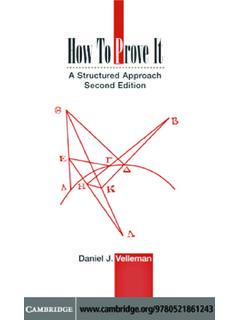Transcription of ME 310 Numerical Methods Interpolation
1 ME 310. Numerical Methods Interpolation These presentations are prepared by Dr. Cuneyt Sert Mechanical Engineering Department Middle East Technical University Ankara, Turkey They can not be used without the permission of the author 1. Interpolation Estimating intermediate values between precise data points. We first fit a function that exactly passes through the given data points and than evaluate intermediate values using this function. Polynomial Interpolation Spline Interpolation f(x) f(x). extrapolation Interpolation x x Polynomial Interpolation : A unique nth order polynomial passes through n points. Newton's Divided Difference Interpolating Polynomials Lagrange Interpolating Polynomials Spline Interpolation : Pass different curves (mostly 3rd order) through different subsets of the data points.
2 2. Polynomial Interpolation Given the following n+1 data points (x1, y1), (x2, y2), (x3, y3), .., (xn+1, yn+1). there is a unique nth order polynomial that passes through them p(x) = a0 + a1 x + a2 x2 + .. + an xn The question is to find the coefficients a0 , a1 , .., an Linear Interpolation : Given: (x0, y0) and (x1, y1). A straight line passes from these two points. y1 = f(x1) Using similar triangles a0 + a 1 x f(x) = ? f (x ) f (x 0 ) f (x 1 ) f (x 0 ).. x x0 x1 x 0. y0 = f(x0). x x0 x x1 f (x 1 ) f (x 0 ). f (x ) f (x 0 ) (x x 0 ). x1 x 0. or f1 (x ) b 0 b1 (x x 0 ). Linear Interpolation formula 3. Polynomial Interpolation Quadratic Interpolation : Given: (x0, y0) , (x1, y1) and (x2, y2). y2 = f(x2) A parabola passes from these three points.
3 Y1 = f(x1) Similar to the linear case, the equation of this parabola can be written as a0 + a 1 x + a 2 x2. f2 (x ) b 0 b1 (x x 0 ) b2 (x x 0 )( x x 1 ). y0 = f(x0). x x0 x1 x2 Quadratic Interpolation formula How to find b0, b1 and b2 in terms of given quantities? at x=x0 f2(x) = f(x0) = b0 b 0 f(x 0 ). f (x 1 ) f(x 0 ). at x=x1 f2(x) = f(x1) = b0 + b1x1 b1 . x1 x 0. at x=x2 f2(x) = f(x2) = b0 + b1(x2-x0)+ b2 (x2-x0) (x2-x1). f (x 2 ) f(x 1 ) f (x 1 ) f(x 0 ).. x2 x1 x1 x 0. b2 . x2 x 0. 4. Newton's Divided Difference Interpolating Polynomials We can generalize the linear and quadratic Interpolation formulas for an nth order polynomial passing through n+1 points fn(x) = b0 + b1 (x - x0) + b2 (x - x0)(x - x1) + .. + bn (x - x0)(x - x1).
4 (x - xn-1). where the constants are b0 = f(x0) b1 = f [x1, x0] b2 = f [x2, x1, x0] .. bn = f [xn, xn-1, .., x1, x0]. where the bracketed functions are finite divided differences evaluated recursively f (x i ) f(x j ). f [x i , x j ] 1st finite divided difference xi x j f [x i , x j ] f [x j , x k ]. f [x i , x j , x k ] 2nd finite divided difference xi xk f [x n , x n 1 , .., x 1 ] f [x n 1 , .., x 1 , x 0 ] nth finite divided difference f [x n , x n 1 , .., x 1 , x 0 ] . xn x 0. There nth order Newton's Divided Difference Interpolating polynomial is fn(x) = f(x0) + (x - x0) f[x1, x0] + (x - x0)(x - x1) f[x2, x1, x0] + .. + (x - x0)(x - x1) .. (x - xn-1) f[xn, xn-1, .., x1, x0] 5. Example 29: The following logarithmic table is given.
5 X f(x)=log(x). (a) Interpolate log(5) using the points x=4 and x=6. (b) Interpolate log(5) using the points x= and x= Note that the exact value is log(5) = (a) Linear Interpolation . f(x) = f(x0) + (x - x0) f[x1, x0]. x0 = 4, x1 = 6 f[x1, x0] = [f(6) f(4)] / (6 - 4) = f(5) f(4) + (5 - 4) = et = %. (b) Again linear Interpolation . But this time x0 = , x1 = f[x1, x0] = [f( ) f( )] / ( - ) = f(5) f( ) + (5 ) = et = %. 6. Example 29 (cont'd): x f(x)=log(x) (c) Interpolate log(5) using the points x= , x= and x=6. (c) Quadratic Interpolation . x0 = , x1 = , x2 = 6 f[x1, x0] = (already calculated). f[x2, x1] = [f(6) f( )] / (6 ) = f[x2, x1 , x0] = {f[x2, x1] - f[x1, x0]} / (6 ) = f(5) + (5 - )(5 - ) ( ) = et = %. Note that was calculate in part (b).
6 Errors decrease when the points used are closer to the interpolated point. Errors decrease as the degree of the interpolating polynomial increases. 7. Finite Divided Difference (FDD) Table Finite divided differences used in the Newton's Interpolating Polynomials can be presented in a table form. This makes the calculations much simpler. x f( ) f[, ] f[, ,] f[, , ,]. x0 f(x0) f [x1 , x0] f [x2 , x1 , x0] f [x3 , x2 , x1 , x0]. x1 f(x1) f [x2 , x1] f [x3 , x2 , x1]. x2 f(x2) f [x3 , x2]. x3 f(x3). Exercise 27: The first two columns of the following table is given. Calculate the missing finite divided differences. x f( ) f[, ] f[, ,] f[, , ,]. 4 ? ? ? ? ? ? 6 The numbers decrease as we go right in the table. This means that the contribution of higher order terms are less than the lower order terms.
7 This is expected. The opposite behavior is an indication of an inappropriate Interpolation (see exam questions of Fall 2006). 8. Example 30: x f( ) f[, ] f[, ,] f[, , ,]. 4 6 Use this previously calculated table to interpolate for log(5). (a) Using points x=4 and x= log (5) + (5 - 4) = et = % (this is extrapolation). (b) Using points x= and x= log (5) + (5 - ) = et = %. (c) Using points x=4 and x=6. The entries of the above table can not be used for this Interpolation . (d) Using points x= , x= and x=6. log (5) + ( ) + ( )( )( )= et = %. (e) Using all four points. log (5) + (5 - 4) + (5 - 4)(5 - )( ). + (5 - 4)(5 - )(5 )( ) = et = % 9. Exercise 28: Create the FDD table for the given data set. Use it to x f( ). interpolate for f(2).
8 -2 For a linear Interpolation use the points x=1 and x=3. -1 For a quadratic Interpolation either use the points x=0, x=1. 0 and x=3 or the points x=1, x=3 and x=4. 1 For a third cubic Interpolation use the points x=0, x=1, x=3. 3 and x=4. 4 Important: Always try to put the interpolated point at the 6 center of the points used for the Interpolation . Exercise 29: Complete the following table given for the log function. Do you observe anything strange? Comment. x f( ) f[, ] f[, ,] f[, , ,] f[, , , ,] f[, , , , ,]. 1. 3. 5. 8. 10. 10. Errors of Newton's DD Interpolating Polynomials fn(x) = f(x0) + (x - x0) f[x1, x0] + (x - x0)(x - x1) f[x2, x1, x0] + .. + (x - x0)(x - x1) .. (x - xn-1) f[xn, xn-1, .., x1, x0]. The structure of Newton's Interpolating Polynomials is similar to the Taylor series.
9 F n 1 (x). Remainder (truncation error) for the Taylor series was Rn ( x i 1 x i )n 1. (n 1)! Similarly the remainder for the nth order interpolating polynomial is f n 1 (x ). Rn ( x x 0 )( x x 1 ) .. ( x x n ). (n 1)! where x is somewhere in the interval containing the interpolated point x and other data points. But usually only the set of data points is given and the function f is not known. An alternative formulation uses a finite divided difference to approximate the (n+1)th derivative. R n f[x , x n , x n 1 , .. , x 0 ] (x x 0 )( x x 1 ) .. (x x n ). But this includes f(x) which is not known. Error can be predicted if an additional data point (xn+1) is availbale R n f[x n 1 , x n , x n 1 , .. , x 0 ] (x x 0 )( x x 1 ).
10 (x x n ). which is nothing but fn+1(x) - fn(x) 11. Newton's Interpolating Polynomials for Equally Spaced Data If the data points are equally spaced and in ascending order, that is, (x0, y0) , (x0 + h, y1) , (x0 + 2h, y1) , .. , (x0 + nh, yn). finite divided difference simplify. f (x 1 ) f(x 0 ) f (x 0 ). f [x 1 , x 0 ] . x1 x 0 h f (x 2 ) f(x 1 ) f (x 1 ) f(x 0 ).. x2 x1 x1 x 0 f ( x 2 ) 2 f ( x 1 ) f ( x 0 ) f 2 ( x 0 ). f [x 2 , x 1 , x 0 ] . x2 x 0 2h2 2h2. f n ( x 0 ). or in general f [x n , x n 1 ,.., x 0 ] . n! hn where fn(x0) is the nth forward difference. With this notation Newton's DD Interpolating polynomials simplify to fn(x) = f(x0) + f(x0) a + 2f(x0) a(a - 1) / 2! + .. + nf(x0) a(a - 1) .. (a - n + 1) / n!















